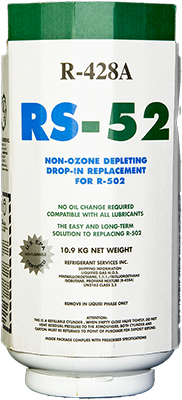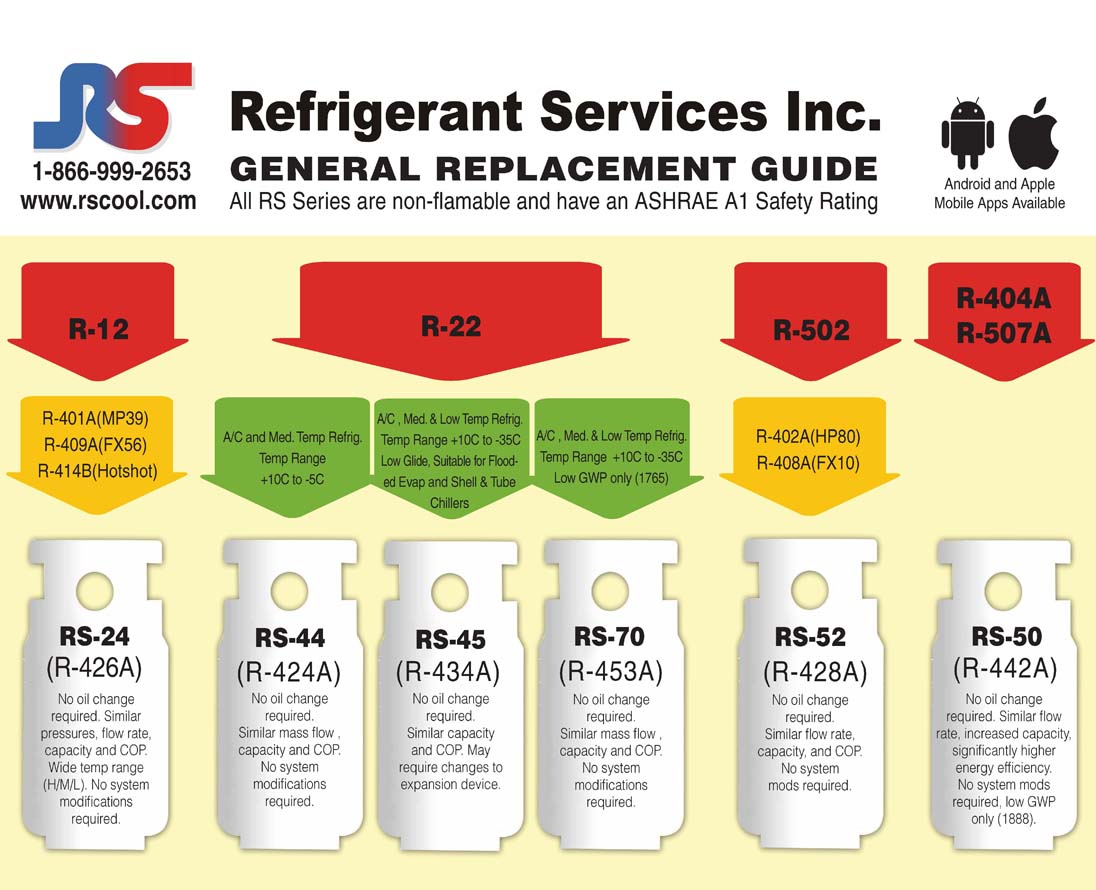RS-52 (R428A)
Type and Description
RS-52 is a non flammable blend of HFC 125, HFC 143a, isobutane and propane which has a zero ODP and is also compatible with both traditional and synthetic lubricants so that a retrofit is not required.
RS-52 is a “Drop-in” replacement for R502 providing an easy and at the same time a long term solution. Because there is no need to use expensive and hygroscopic synthetic lubricants, the risk of moisture ingress into a refrigeration system is completely avoided. RS-52 has significantly lower discharge temperatures and pressures than R502 which removes the problem of oil decomposition and also widens the applications for RS-52
Applications
RS-52 is suitable for use as a replacement for R502 in existing commercial and industrial air conditioning and refrigeration systems, and appliances.
Service Work
Because it is a blend, it is a recommended that RS-52 be charged into systems as a liquid as opposed to the gaseous phase. Since there is no need to change the existing lubricant, RS-52 is straightforward to use, as the following procedure outlines.
Conversion procedure for replacing R-502 with RS-52
- Ensure the right equipment is available, e.g. Recovery unit and cylinders, container for recovered lubricant, vacuum pump, weighing scales, replacement drier etc…
- Record baseline data to establish the normal operating conditions for the equipment.
- Recover the R-502 charge and weigh recovered amount of R502 to determine amount of RS-52 to be charged.
- RS-52 is compatible with MO/AB and POE oils. If however the oil in the system is being changed to a different type it is not necessary to remove all the existing oil in the system.
- Replace the filter/drier
- Evacuate the system and liquid charge with RS-52, am amount approx. 10% less than the original charge of R-502.
- Start the system and check baseline data, adjust the expansion device if required. If a low pressure control functions as a temperature control, check the space temperature and adjust if necessary.
- If the system is fitted with a refrigerant sight-glass and the sight-glass is not indicating a full charge additional RS-52 may be added. Avoid overcharging the system.
- Check system thoroughly for leaks.
- Clearly label sytem as charged with RS-52 and type of oil used.
- On larger systems fitted with an oil sight-glass. Check oil level after several hours of operation and add oil if necessary.

NOTE: Systems with inherent poor oil return, such as systems with unusually long suction lines and/or low temperature systems, may have improved RS-52 oil return capabilities with alklybenzene or polyolester oils.
Lubricants
RS-52 is compatible with both mineral and alkylbenzene oils found in R502 systems, and also with the polyoester lubricants. Therefore, there is no need to change the lubricant although compressor manufacturers’ recommendations regarding lubricity should be followed.
Materials Compatibility
RS-52 is compatible with all materials commonly used in refrigeration systems previously charged with R502. In general, materials which are compatible with R502 can be used with RS-52. It is recommended to check equipment manufacturer’s retrofit literature and obtain recommendations from equipment manufacturers with regard to materials’ compatibility.
Environmental Data
None of the components of RS-52 contains chlorine so that it has no ability to deplete the ozone layer.
As with all the hydrofluorocarbons (HFCs), RS-52 does have a direct global warming potential (GWP), but this is counterbalanced by its lower Total Equivalent Warming Impact (TEWI).
Composition
| HFC 125 HFC 143a Isobutane Propane |
|
| Chemical name | Pentafluoroethane/1,1,1,-Trifluoroethane/Isobutane/Propane |
| Type | HFC blend |
| CFC Replacement | R502 |
| HCFC Replacement | R-22 (low temp), R-408A (FX10), R-401A (HP80) |
| Temperature glide | Approximately 0.9°C |
| Drop-in or long term | Both |
| Lubricant | MO/AB/POE |
| ODP | Zero |
| Atmospheric lifetime | 37 years |
| GWP 100 year ITH 500 year ITH |
3100 1075 |
RS-52 Physical Properties
| RS-52 | R502 | ||
| Molecular weight | 101.3 | 111.6 | |
| Boiling point (1 atm) | °C | -46.7(1) | -45.4 |
| °F | -52.1(1) | -49.7 | |
| Temperature glide | °C | 0.8 | 0.2 |
| Critical temperature | °C | 73.0 | 82.2 |
| °F | 163.4 | 180.0 | |
| Critical pressure | bara | 38.1 | 40.7 |
| psia | 552 | 59.1 | |
| Liquid density at 25°C | Kg/m3 | 1053 | 1217 |
| Density of saturated vapour at 25°C | kg/m3 | 70.2 | 62.2 |
| Specific heat of liquid at 25°C | kj/kg°C | 1.52 | 1.25 |
| Specific heat of vapour at 1 atm & 25°C | kj/kg°C | 0.706 | |
| Vapour pressure at 25°C | bara | 12.68(1) | 11.5 |
| psia | 183.9(1) | 167 | |
| Latent heat of vaporisation at boiling point | kj/kg | 189.2(1) | 173 |
| Ozone Depletion Potential | ODP | 0 | 0.33 |
| Flammability limit in air (1 atm) | vol% | None | None |
| Inhalation exposure (8 hr day & 40 hr week) | ppm | 1000 | 1000 |

 A Cool New World.
A Cool New World. 